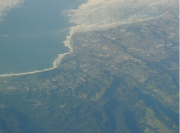Abiodun
Abiodun is a large town, port and tourist destination in Candelaria And Marquez, situated on south-east coast of the island of Candelaria. The original town of Abingdon – which is how the city is still, and has apparently always been, pronounced – was founded in 1809; making it one of the oldest settlements in the British Candelarias. The awkward terrain of Candelaria, even on the coasts, made expansion difficult; and Abingdon became just one of numerous small fishing villages. Later British settlements to the north, particularly around what would become the Albrecht Cove and in the north-east, met with rather greater success; though for much of the early nineteenth century Abingdon was considered a notable port, with an important part to play in the wool trade. Greater urbanisation and industrialism saw the town’s port status become rather more important in the later nineteenth century; a time which also saw the fanciful adoption of ‘Abiodun’ as the town’s official name. As a spelling it stuck, but the proposed pronunciation never caught on. The strength of Albrecht, Arrigo, Bass, Bove, Zapata et al as ports in the islands, coupled with the Abiodun region’s shallow waters, saw the townsfolk look towards other industries to maintain the town’s burgeoning wealth. The beaches and landscape of the region began to attract increasingly large numbers of tourists throughout the late nineteenth century; with tourism eventually becoming, after the service sector, the town’s greatest area of employment. A wide range of other forms of employment are available however, mostly in heavy-goods construction but also cosmetics, publishing, banking and, of course, fishing. As well known nationally as the town itself is the south-western costal district of Gamboa. An area of early mercantile prosperity while other parts of the town were rapidly becoming overcrowded and poverty stricken; Gamboa has retained a status as the home of costal Candelarian affluence ever since. Today, it remains the most expensive and exclusive district in the entire country, its main road (‘millionaire’s row’) having one of the highest land values, by area, in the entire region even despite C&M’s high taxation. Though not all of Gamboa is quite as salubrious as that part labelled as the Candelarias’ “Orange County”; the district as a whole is still very wealthy. It boasts C&M’s most popular sailing and yachting clubs, though Candelariasians of all social backgrounds are able to make use of its beaches and crystal-clear waters for watersports of all types. |
|||||||||||

